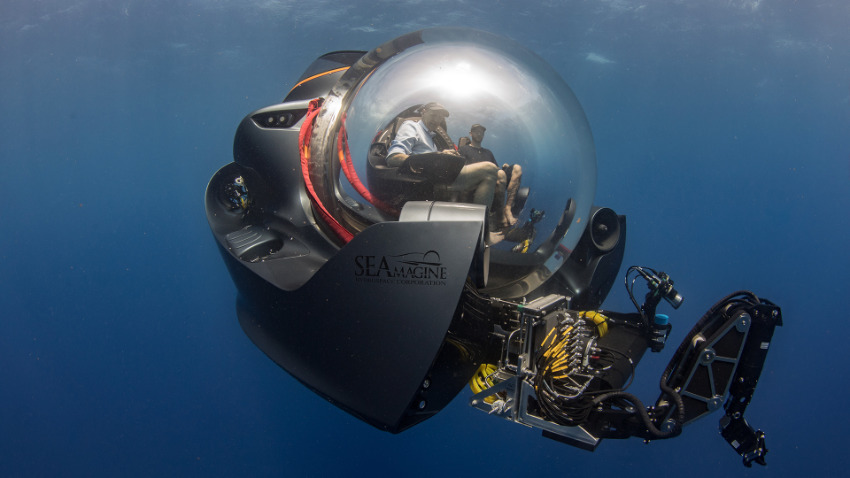

| » Forum Index » Problems and solutions » Topic: Creating the distortions for the underwater Supersub challenge. |
|
Posted on 03/02/25 4:37:07 PM |
|
DavidMac
Director of Photoshop Posts: 5930 Reply  |
Creating the distortions for the underwater Supersub challenge.
When I came to do the Supersub challenge I realised that looking into the domed front was going to produce distortions as the glass to air interface constituted a huge deeply curved lens. Since the view point was in water and the dome filled with air it seemed reasonable to suppose that this would be the inverse of the fishbowl effect where fish in the bowl can become spherically enlarged and distorted depending on their position in the bowl. However, when I started to research this I discovered all sorts of factors that I had never anticipated. To begin with we need to look at a phenomenon known as The angle of total internal reflection. Without getting too technical this occurs when the viewpoint is in a denser more refractive medium (eg. glass or water) looking out into a less dense less refractive medium such as air. If we imagine an underwater camera or diver looking vertically upwards at the underside of a perfectly flat undisturbed water surface then what would happen is shown in the pretty little diagram I have have drawn for you below. For the purposes of visualisation, it is easier to imagine a light source in the position of the eye, radiating rays of light. Light passing through surface at 90° will pass straight through without refraction. As the light starts to hit the surface at an angle it will start to become refracted. The greater the angle of the light passing through the surface the greater the amount it will be refracted. (Red lines) This goes on until we reach the critical angle of 49° at which point the refraction will be parallel to the surface. (Green line) Beyond this critical angle light will no longer pass through the surface but will be reflected downwards following the classic rule of angle of reflection equal to angle of incidence. (Blue lines) 
Precisely the same "bending' and reflecting applies in reverse with light coming 'in' from above. The effect being that we can see 'out' through a 'hole' where the image is progressively distorted towards its edges. Beyond the edges of the 'hole' we will see the reflection of whatever is below. This phenomenon is known as Snells Window Here are a couple of photos showing the effect. Obviously because in real life water moves the edges of the hole are not completely clean. 
So far so simple but here is where it gets surprising. when we look at the people in the sub we are looking through a totally smooth water to air surface that is steeply curved. If we apply the principles shown above we get this result shown below. The edges of the sphere present an angle that is within the angle of total reflection. Therefore we cannot we cannot see into the sphere at its edges because it reflects whatever is around it. However as we move closer to the centre of the sphere we are able to see through. It's the same 'hole' that occurs in the examples above. The image we see is refracted towards the edges of the hole and un-refracted at the centre. Because of the curvature this has the effect of enlarging the interior as we approach the edge of the 'hole'. Because the surface is completely smooth the border between transmission and reflection is very well defined. The relative size of the transparent centre and the reflective outer ring is going to change somewhat with distance as the angles subtended between the line point of vision and the surface of the sphere change too. 
Here are some real life examples. You can clearly see the clean border between reflection of the exterior at the edge of the sphere and the distorted interior at the centre of the sphere. 
Now you can see what I attempted to do. It's surprisingly hard to achieve with photoshop distortions. I had to do it in the end by hand and eye and the end result leaves much to be desired. 
I suspect the only person who could really get this right would be Dwindt. But I doubt this falls within the scope of a 'standard' render. I imagine a 'standard' render I would cope with an air to water refraction but would it be easy to set up for water to air? My guess is that you would need to specify indexes of refraction manually. So there we are. An unexpected surprise ............well ......... for me, at any rate! _________________ The subtlety and conviction of any Photoshop effect is invariably inversely proportional to the number of knobs on it ....... |
Posted on 03/02/25 5:30:52 PM |
|
GKB
Magical Montagist Posts: 4084 Reply |
Re: Creating the distortions for the underwater Supersub challenge.
A complex bit of optical physics here, some of which may well produce results that are counter-intuitive. To replicate this in, say, Cinema, I reckon that you would have to create a sphere with a slightly smaller sphere and subtract the smaller from the larger (Boolean). This would give you a thin empty shell. Give this shell the refractive index of a transparent polycarbonate. Now create a box around the shell and, possibly, subtract the shell from the interior of the box (another Boolean) and give this box the transparency and refractive index of water. What you hopefully now have will be an empty sphere filled with air progressing to the polycarbonate to the water with two refractive surfaces on the shell. To see what effect you might have, place a 3D object inside the shell. The effect may well increase depending on how thick you make the polycarbonate shell. I am away from home at the moment but might have a bash at this when I get back and can take a break from trying to save the human race from itself _________________ Why is it that all the contestants in the ‘Miss Universe’ contest are all from Earth? |
Posted on 03/02/25 6:01:46 PM |
|
GKB
Magical Montagist Posts: 4084 Reply |
Re: Creating the distortions for the underwater Supersub challenge.
Here is an actual midget sub from SeaImagine shot underwater.This shows the fisheye effect of the various refractive indices. 
_________________ Whatever you do in life do it with the enthusiasm of a 4-year old in a Batman suit. |
Posted on 03/02/25 8:54:47 PM |
|
DavidMac
Director of Photoshop Posts: 5930 Reply  |
Re: Creating the distortions for the underwater Supersub challenge.
Yes it shows exactly the same effect I was illustrating. _________________ The subtlety and conviction of any Photoshop effect is invariably inversely proportional to the number of knobs on it ....... |
Posted on 03/02/25 9:19:05 PM |
|
DavidMac
Director of Photoshop Posts: 5930 Reply  |
Re: Creating the distortions for the underwater Supersub challenge.
Not really being conversant with 3D rendering I am not convinced that I have followed that entirely. But I think I have. My instincts tell me that, in any calculation, the important refraction is exterior water to interior air. I would have thought, that unless you are making a super precise scientific render to the ultimate decimal point, the thickness of the polycarbonate and whatever tiny extra refraction it might cause can simply be simply ignored. My feeling is that the render could be treated simply and pragmatically as if the water magically interfaced spherically directly with the air. It's a visual render. Not a scientific analysis!  _________________ The subtlety and conviction of any Photoshop effect is invariably inversely proportional to the number of knobs on it ....... |